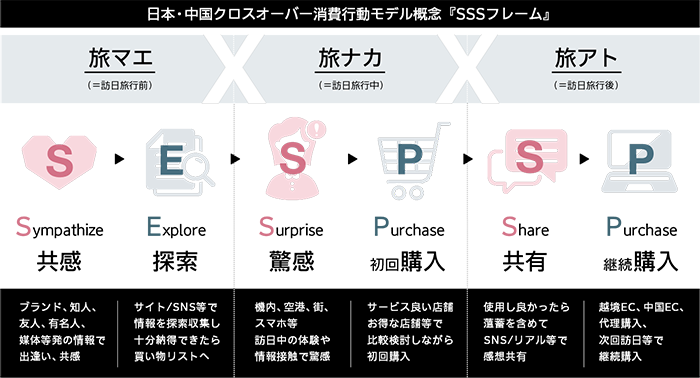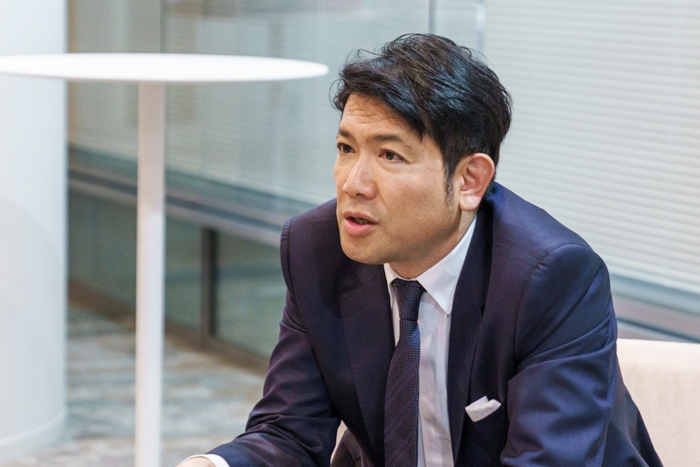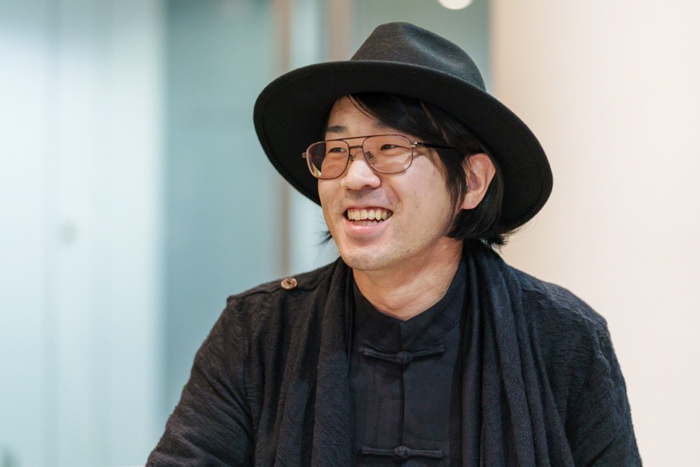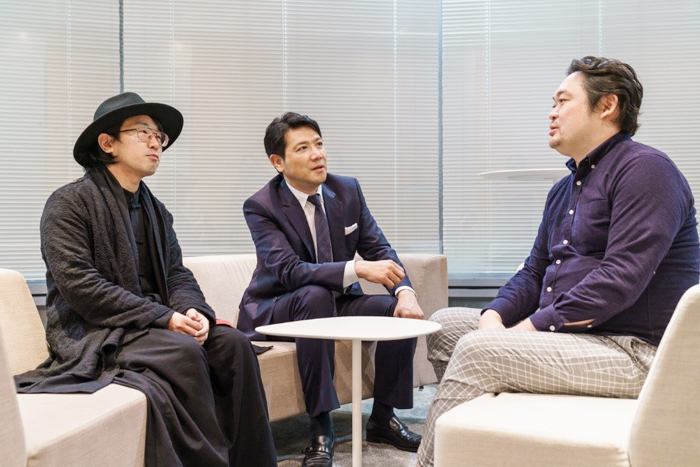For Japanese companies struggling with declining domestic demand, the importance of inbound business from China and cross-border e-commerce is growing ever greater. Dentsu CXC developed the Japan-China Cross-Over Consumer Behavior Model concept, "SSS Frame," which categorizes Chinese consumer behavior into three stages: Pre-trip (Sympathize), During-trip (Surprise), and Post-trip (Share), representing the psychological transformation of consumers.
Among these three stages, the most distinctive is the pre-trip "Sympathize" phase. In China, the volume of online information increases annually. Relying solely on traditional advertising approaches that unilaterally convey information is insufficient to drive purchases of products or services. The key to conquering this market lies in leveraging the narrative power of entertainment content to gain "sympathy."
Dentsu Inc. CXC Planner Takashi Mutō interviewed actor Tetsuya Bessho, who has long hosted his own short film festival and is well-versed in China's content landscape, and Japanese creator Tomohiro Yamashita, who has gained popularity by sharing authentic Japanese local culture on Chinese video platforms, to learn key points for expanding into the Chinese market.
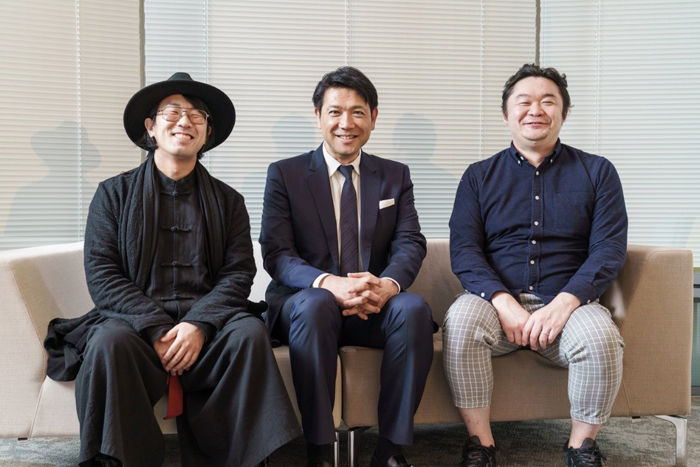
From left: Tomohiro Yamashita, Tetsuya Bessho, Takashi Muto (Dentsu Inc.)
Building a Global Platform Connecting Japan and the World
Muto: In recent years, the volume of online information has surged globally. Data shows information volume expanded 40-fold from 2010 to 2020, and I imagine China faces a similar situation. In this era of information-saturated social media, I believe gaining users' "empathy" is crucial to getting them to purchase products.
Mr. Yamashita, you've been active as a content creator on the Chinese video platform Bilibili, amassing over 2 million subscribers despite being a Japanese creator. You've achieved truly charismatic popularity among Chinese fans. Was there a specific catalyst for this explosive popularity?
Yamashita: I started uploading videos for Chinese viewers back in 2013. At that time, China was still in the early days of the internet—there weren't many people making videos, and platforms like video streaming sites didn't exist yet. Conversely, in Japan around that time, the culture of YouTubers streaming content was slowly starting to gain momentum. I was certain this trend would eventually reach China too.

Tomohiro Yamashita, Nuru Nuru Co., Ltd.
For young people in China back then, Japan was just the world of anime and dramas. They imagined Japanese school festivals with incredibly talented student bands, everyone confessing under the cherry trees on campus... That kind of thing. So, for Chinese youth who only knew this glamorous image of Japanese school life, when I, as the "representative of the uncool kids," showed them "This is what real school life is like for young Japanese people," it seems they realized, "Huh? It's not that different from China after all." That's why I think we resonated with young people who were actually seeking the "real Japan."
Muto: Mr. Yamashita, you launched "Nurunuru Inc." this year. What's the goal behind that?
Yamashita: Our main business now is "localizing Japanese-made content for China." We want to pick things that exist in Japan but not in China, things that seem likely to become popular there, and take on the challenge of arranging them into a form that will be accepted by Chinese audiences and delivering them. Currently, the content I'm focusing on bringing to China is Japanese music videos and variety show formats. I think they could potentially become popular there too. To test this, I'm already streaming pre-produced content on my own channel to gauge reactions, and the variety shows are showing promising signs of success. I want to make my channel an open platform where the Japanese team can test and stream their prototypes.
Muto: Speaking of platforms serving as gateways for all kinds of content, while you're strongly associated with acting, Mr. Bessho, you've actually been organizing the "SSFF (Short Shorts Film Festival)"—a film festival exclusively for short films—for many years, right?
Bessho: The impetus for creating the film festival came from my time as an actor in America.
Around 1989, when I was in Hollywood, I was told, "Japanese people can make things, but they can't build platforms," and "They can't do the archive auction business." I was in my twenties then, so it didn't really click. But it's true, we Japanese have this reserved mindset that "if we just quietly make good stuff, it will sell and get noticed" (laughs).
Japan has this brand image of "high-quality products and content," which is great. But perhaps because we're so confident in our craftsmanship, we fall short in the communication that follows.
When I became captivated by the appeal of short films, I realized we really needed a platform to share them with the world. That's why I created SSFF – a place where works gather, people gather, and short films are ranked.
The necessity of not just creating, but also broadcasting from Japan to the world
Yamashita: Exactly. Japanese content holders often have great content, but they just sell licenses to overseas agencies and call it a day. They don't get involved in the subsequent local rollout, which is such a waste. The idea that if you make something good, it will sell itself is an illusion.
Considering that, I think it's incredibly valuable that Mr. Bessho created the SSFF platform, not just introducing content locally but actively expanding it as a business in various countries.
Muto: Following this thread, I'd like to ask about the "Branded Shorts" category, an official section of SSFF. Why did you create this category?

Takashi Muto, First Integrated Solutions Bureau
Bessho: Branded Shorts are short film content that resonates with users by delivering corporate or brand messages not as mere advertising videos, but as entertaining videos with narrative depth. Recently, we're seeing more cases where products don't sell simply because of mass advertising campaigns. For example, rice crackers from a small shop in Otaru suddenly gained attention through word-of-mouth from Chinese influencers and were being bought in bulk by Chinese tourists.
Muto: I often hear clients say they have no idea why sales suddenly spiked (laughs).
Yamashita: In today's world, prices and quality for most products and services are pretty much on par. So, people need something else to base their choices on—like word-of-mouth or the story behind the product—otherwise it's hard to decide.
Bessho: Take buying diapers, for instance. People are more likely to buy the ones recommended by a trusted mom friend who says, "These are the diapers my kid used, I recommend them," rather than ones touted in a TV commercial narration like, "These diapers excel in functionality and feature a design focused on..." In this case, knowing the mom friend's struggles with childcare makes her story relatable. You buy because you connect with the mother's story behind it, or the sincere intentions of the people making the product, or something that aligns with your own values.
In that sense, branded shorts—stories with strong narratives that evoke empathy—become incredibly effective. So while corporate demand was part of our founding reason, it was also something that naturally emerged to meet global demand.
The key to compelling stories lies in blending "empathy" and "discomfort"
Muto: It seems there are common elements behind content that resonates with people.
Yamashita: While the product's own story is important, it's the story that develops between the user and the product that keeps them loyal. Stories like, "I keep using this product because of this experience I had," or "I go back here every year because of this reason."
In my case, I want to provide lifelong aftercare for people who encountered my weird videos during their impressionable years and just couldn't get them out of their heads (laughs). If I can become someone those fans think, "I want to support Yamashita for working hard for the Chinese people, and if Yamashita says something is good, I want to see it," then the relationship will last forever, and there won't be any lies or deception. That's what I want to keep doing.
Bessho: Empathy is important, but I think valuing that "sense of dissonance" is key. Because cultures and values differ between countries, right? How you strike a fighting pose, how you shake hands, how you drink alcohol – it's different in Japan and China. I think it's good to communicate both empathy and that dissonance together, without denying it. Not in a bad way – ultimately, it's about being able to joke around and acknowledge differences.
Yamashita: In that sense, I want to create a platform that enables more Japanese creators to actively engage with China. I hope this leads to more high-quality Japan-China collaborations.
Bessho: We can do it. With the vibe of "We're both Asians, so let's shake hands and make a name for ourselves in the world!" (laughs). Even if we don't understand each other's language, we can communicate by writing if we try hard enough. I'm looking forward to even greater collaboration between China and Japan.
For inquiries, please contact us here.
Dentsu Inc. Dentsu CXC
Email: dentsucxc@dentsu.co.jp



